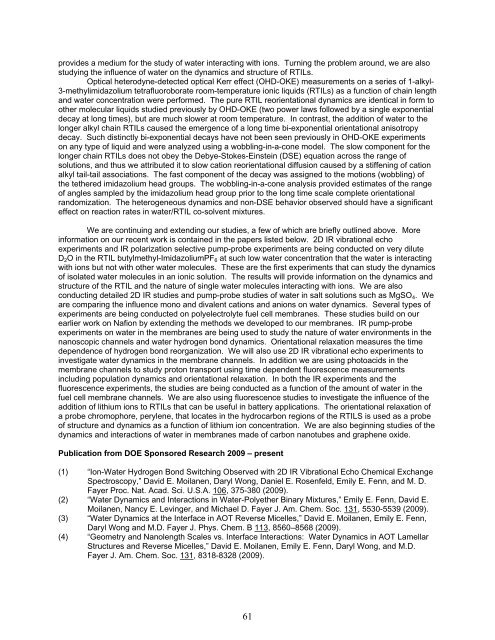Eighth Condensed Phase and Interfacial Molecular Science (CPIMS)
Eighth Condensed Phase and Interfacial Molecular Science (CPIMS)
Eighth Condensed Phase and Interfacial Molecular Science (CPIMS)
You also want an ePaper? Increase the reach of your titles
YUMPU automatically turns print PDFs into web optimized ePapers that Google loves.
provides a medium for the study of water interacting with ions. Turning the problem around, we are also<br />
studying the influence of water on the dynamics <strong>and</strong> structure of RTILs.<br />
Optical heterodyne-detected optical Kerr effect (OHD-OKE) measurements on a series of 1-alkyl-<br />
3-methylimidazolium tetrafluoroborate room-temperature ionic liquids (RTILs) as a function of chain length<br />
<strong>and</strong> water concentration were performed. The pure RTIL reorientational dynamics are identical in form to<br />
other molecular liquids studied previously by OHD-OKE (two power laws followed by a single exponential<br />
decay at long times), but are much slower at room temperature. In contrast, the addition of water to the<br />
longer alkyl chain RTILs caused the emergence of a long time bi-exponential orientational anisotropy<br />
decay. Such distinctly bi-exponential decays have not been seen previously in OHD-OKE experiments<br />
on any type of liquid <strong>and</strong> were analyzed using a wobbling-in-a-cone model. The slow component for the<br />
longer chain RTILs does not obey the Debye-Stokes-Einstein (DSE) equation across the range of<br />
solutions, <strong>and</strong> thus we attributed it to slow cation reorientational diffusion caused by a stiffening of cation<br />
alkyl tail-tail associations. The fast component of the decay was assigned to the motions (wobbling) of<br />
the tethered imidazolium head groups. The wobbling-in-a-cone analysis provided estimates of the range<br />
of angles sampled by the imidazolium head group prior to the long time scale complete orientational<br />
r<strong>and</strong>omization. The heterogeneous dynamics <strong>and</strong> non-DSE behavior observed should have a significant<br />
effect on reaction rates in water/RTIL co-solvent mixtures.<br />
We are continuing <strong>and</strong> extending our studies, a few of which are briefly outlined above. More<br />
information on our recent work is contained in the papers listed below. 2D IR vibrational echo<br />
experiments <strong>and</strong> IR polarization selective pump-probe experiments are being conducted on very dilute<br />
D2O in the RTIL butylmethyl-ImidazoliumPF6 at such low water concentration that the water is interacting<br />
with ions but not with other water molecules. These are the first experiments that can study the dynamics<br />
of isolated water molecules in an ionic solution. The results will provide information on the dynamics <strong>and</strong><br />
structure of the RTIL <strong>and</strong> the nature of single water molecules interacting with ions. We are also<br />
conducting detailed 2D IR studies <strong>and</strong> pump-probe studies of water in salt solutions such as MgSO4. We<br />
are comparing the influence mono <strong>and</strong> divalent cations <strong>and</strong> anions on water dynamics. Several types of<br />
experiments are being conducted on polyelectrolyte fuel cell membranes. These studies build on our<br />
earlier work on Nafion by extending the methods we developed to our membranes. IR pump-probe<br />
experiments on water in the membranes are being used to study the nature of water environments in the<br />
nanoscopic channels <strong>and</strong> water hydrogen bond dynamics. Orientational relaxation measures the time<br />
dependence of hydrogen bond reorganization. We will also use 2D IR vibrational echo experiments to<br />
investigate water dynamics in the membrane channels. In addition we are using photoacids in the<br />
membrane channels to study proton transport using time dependent fluorescence measurements<br />
including population dynamics <strong>and</strong> orientational relaxation. In both the IR experiments <strong>and</strong> the<br />
fluorescence experiments, the studies are being conducted as a function of the amount of water in the<br />
fuel cell membrane channels. We are also using fluorescence studies to investigate the influence of the<br />
addition of lithium ions to RTILs that can be useful in battery applications. The orientational relaxation of<br />
a probe chromophore, perylene, that locates in the hydrocarbon regions of the RTILS is used as a probe<br />
of structure <strong>and</strong> dynamics as a function of lithium ion concentration. We are also beginning studies of the<br />
dynamics <strong>and</strong> interactions of water in membranes made of carbon nanotubes <strong>and</strong> graphene oxide.<br />
Publication from DOE Sponsored Research 2009 – present<br />
(1) “Ion-Water Hydrogen Bond Switching Observed with 2D IR Vibrational Echo Chemical Exchange<br />
Spectroscopy,” David E. Moilanen, Daryl Wong, Daniel E. Rosenfeld, Emily E. Fenn, <strong>and</strong> M. D.<br />
Fayer Proc. Nat. Acad. Sci. U.S.A. 106, 375-380 (2009).<br />
(2) “Water Dynamics <strong>and</strong> Interactions in Water-Polyether Binary Mixtures,” Emily E. Fenn, David E.<br />
Moilanen, Nancy E. Levinger, <strong>and</strong> Michael D. Fayer J. Am. Chem. Soc. 131, 5530-5539 (2009).<br />
(3) “Water Dynamics at the Interface in AOT Reverse Micelles,” David E. Moilanen, Emily E. Fenn,<br />
Daryl Wong <strong>and</strong> M.D. Fayer J. Phys. Chem. B 113, 8560–8568 (2009).<br />
(4) “Geometry <strong>and</strong> Nanolength Scales vs. Interface Interactions: Water Dynamics in AOT Lamellar<br />
Structures <strong>and</strong> Reverse Micelles,” David E. Moilanen, Emily E. Fenn, Daryl Wong, <strong>and</strong> M.D.<br />
Fayer J. Am. Chem. Soc. 131, 8318-8328 (2009).<br />
61
















